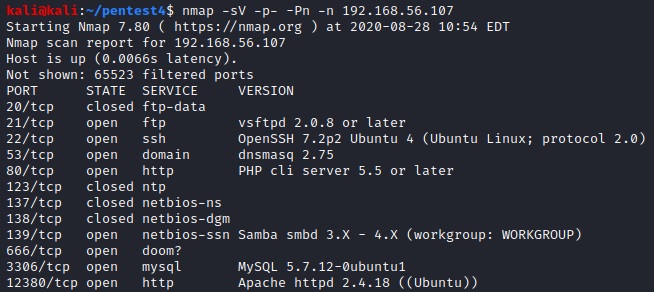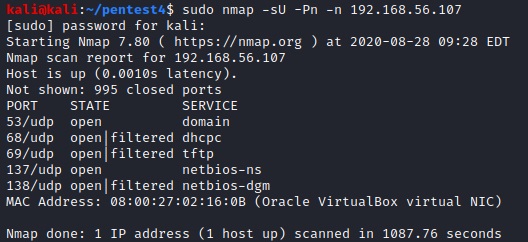After exploiting the first three targets (VulnHub – Basic Pentesting 1, VulnHub – Basic Pentesting 2, and VulnHub – Photographer), I will go through the curated list of OSCP-like machines to improve and get a better feeling for the OSCP level of machines.
Note: I’ll use the “we” form for the writeups, as that’s how I intend to write the reports. For these blurps about my progress etc. I’ll stick with the first person.
Setup
Our attacking box is a virtual machine that has the IP 192.168.56.102 and runs an updated Kali Linux 2020.3. Throughout the penetration test, we will try to avoid using any automated exploitation tools. The target is VulnHub’s Stapler 1, a vulnerable virtual machine to practice penetration testing.
Information Gathering
Portscanning
The first thing we do is find the IP of our target by running nmap against the subnet.
nmap -sn 192.168.56.102/24We learn, that the target IP is 192.168.56.107 and run an nmap scan against that IP against all TCP ports (-p-).
nmap -sV -p- -Pn -n 192.168.56.107
We also scan for the most common open UDP ports (note: this takes a bit of time so we did it while executing some of the steps below).

Webservers
Port 80
Running dirb on the webserver on port 80 reveals two files that we can download (nikto yields the same result).
sudo dirb http://192.168.56.107:80 -f -r
curl http://192.168.56.107:80/.bashrc > bashrc.txt
curl http://192.168.56.107:80/.profile > profile.txtBrowsing 192.168.56.107:80 and looking at the source code yielded nothing interesting.

Port 12380
Running nikto on the webserver running on port 12380 yields some directories (dirb didn’t return any results).
nikto -h 192.168.56.107:12380
Seems like there’s a misconfiguration of SSL and there’s also a user “dave” that shows up in the headers with a comment. There’s also three interesting directories: /admin112233, /blogblog and /phpmyadmin.
We opened 192.168.56.107:12380 in a browser.

The title of the page was “Tim, we need to-do better next year for Initech”, so we can add “Tim” as another potential user. Viewing the source code gave us something interesting.

So we have another potential user “Zoe” (from HR) as well as an interesting string. It seems to be a base64 encoded jpeg image, but we were not able to decode it in any meaningful way.
Samba
Because we saw port 139 open, we run enum4linux to fish for account names and save them to enum.txt.
enum4linux -vr 192.168.56.107 | grep 'Local\|Domain' > enum.txt
We’ll also get a listing of the shares.
enum4linux -vS 192.168.56.107
From the comments, it seems like there are two users, “Fred”, who is on the list (fred) and kathy who doesn’t show up in our enumeration. Let’s try to connect to the kathy and tmp shares and explore them.
smbclient -W 'WORKGROUP' //'192.168.56.107'/'kathy' -U''%'' -c 'ls'smbclient -W 'WORKGROUP' //'192.168.56.107'/'tmp' -U''%'' -c 'ls'
Lets’ quickly check the contents of the two subdirectories kathy_stuff and backup as well and then download everything.

smbclient -W 'WORKGROUP' //'192.168.56.107'/'kathy' -U''%'' -c 'recurse ON; prompt OFF; mget *'smbclient -W 'WORKGROUP' //'192.168.56.107'/'tmp' -U''%'' -c 'recurse ON; prompt OFF; mget *'
The todo-list.txt contains the following information: “I’m making sure to backup anything important for Initech, Kathy”. So we keep in mind, that Initech might be relevant. Using cat to display the ls file, we can see that there used to be another file called “systemd-private-df2bff9b90164a2eadc490c0b8f76087-systemd-timesyncd.service-vFKoxJ” in the tmp directory.

Searching a bit on Google reveals, that these files are created by systemd if the private temp feature is activated [1]. In this case for the timesyncd.service.
We unzipped the wordpress-4.tar.gz file but didn’t find a wp-config.php file inside (which usually contains the database password). The wp-config-sample.php didn’t leak any information.
Let’s get all activated options for vsftpd.
cat vsftpd.conf | grep -v '#'
Lastly, let’s save all the enumerated local usernames in a file (users_enum.txt) for later use.
grep 'Unix' enum.txt | awk '{print $3}' | cut -d '\' -f2 > users_enum.txtFTP
Anonymous login should be enabled, so let’s see what we can do by logging in as ftp and leaving the password empty.

There seems to be an admin user named “Harry” and we can download the note file by issuing “get note”. The note contains the following text: “Elly, make sure you update the payload information. Leave it in your FTP account once your are done, John.” So there’s two more potential users that we can add.
SSH
ssh 192.168.56.107
There seems to be an admin user named “Barry” but we can’t get any further without logging in.
List of users
We found the following usernames from various sources…
- dave – from misconfigured SSL
- Tim – from webserver 2
- Zoe – Head of HR – from webserver 2
- Fred – from samba
- kathy – from samba
- Harry – from FTP
- Elly – from FTP
- John – from FTP
- Barry – from SSH
We create a file called usernames.txt and add one user per line, lowercased to it. We also create a file usernames_cap.txt with the capitalized versions.
sed 's/^./\u&/g' usernames.txt > usernames_cap.txtWe combine all usernames into one master username list called user_list.txt.
cat usernames.txt usernames_cap.txt users_enum.txt >> user_list.txtJust to make sure, we check that there are no duplicates.
uniq -D user_list.txtsearchsploit
Next, we run searchsploit for all open ports. There’s interesting results for OpenSSH, MySQL and dnsmasq.
searchsploit OpenSSH 7.2p2
searchsploit MySQL 5.7.12
searchsploit dnsmasq 2.75
Exploitation
Brute forcing
Let’s try a simple username == password brute force against both FTP and SSH with hydra.
hydra -L user_list.txt -P user_list.txt 192.168.56.107 ftp
hydra -L user_list.txt -P user_list.txt 192.168.56.107 ssh
Seems like the same user (SHayslett) has used his username as a password for FTP and SSH.
If we try to SSH into the machine, we get access to it (note: we also got an exchange_identification error before).

Post Exploitation
First, we check if there’s anything interesting in the /home directory.
ls -Ral /homeThe user peter has a file called .zcompdump in his .cache directory which we can read. He can also sudo to become root as indicated by the .sudo_as_admin_successful file. There’s also an empty file motd.legal-displayed in SHayslett‘s .cache directory which indicates that motd is used.
Next, we run LinEnum to check for common problems by copy&pasting the script from Github [2] into linenum.sh and using chmod +x to make it executable.
./linenum.sh -r linenum
Seem like the user JKanode tried to run ssh in non-interactive mode with sshpass and he passed the passwords via the -p command line argument. We know from before that peter can sudo, so we try to ssh with that password.

After an initial message about z-shell we get access and can become root. And that’s all. Mission accomplished 🙂
Misc
We can try to enumerate existing accounts in OpenSSH [3] before brute forcing. There’s a script for this /usr/share/exploitdb/exploits/linux/remote/40136.py. However, because our Kali uses Python 3.8 we have to change the two calls time.clock(), which was deprecated in 3.8 [4], to time.process_time(). For example, running this against our usernames.txt suggests, that only the user “zoe” from that file exists on the target.
python3 40136.py -U usernames.txt 192.168.56.107
We can double-check this by looking into /etc/passwd. Only “zoe” and “elly” exist as local users on the target. However, elly is explicitly forbidden to access the machine vie DenyUsers in sshd_config.
Lessons Learned
- Keep it simple, stupid (KISS). I spend a couple of hours researching the exploits for dnsmasq and MySQL before I tried to simply use hydra to see if username == password was possible. I’m not 100% sure about the use of hydra but will keep using it for simple or targeted attacks (I’ll keep the runtime under 30 minutes).
- Post exploitation scripts like LinEnum are pretty handy. I’m not 100% sure if they are allowed for OSCP or not. I think I’ll keep using them and manually reproduce the steps that found interesting information. In this case:
for i in $(ls /home) ; do echo "User: $i" && cat "/home/$i/.bash_history"; done- Actually look inside .bash_history, you never know what you might find. I didn’t do it during my manual exploration of /home and only saw it when running LinEnum.
Sources
[1] https://access.redhat.com/discussions/3027351
[2] https://github.com/rebootuser/LinEnum












































